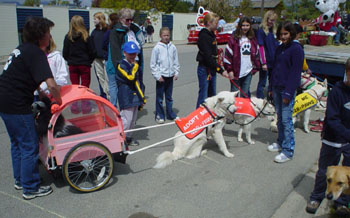Beaverdell/Topaz Seizures
|
SEIZE AND KILL! or RESCUE AND SAVE? CASE 1: Topaz Creek Dogs: Rescued and Saved by CRESTON PAWS SOCIETY Fifty some odd northern mixed-breed dogs tied to trees, neglected and desocialized for years. One group in Topaz Creek BC, one in Beaverdell BC. Two remarkably similar situations, handled by two remarkably different organizations with radically different strategies and outcomes. Scientists themselves couldn't have created two better control groups. Return to SPCA Seizures lead page Click Creston Paws Society to see more about the Topaz Creek dogs.
DATES OF REMOVAL OF DOGS Topaz Creek: Between July 2, 2002 and July 28, 2002. Dogs were rescued and removed as foster space became available by a small rescue organization, Creston PAWS. Beaverdell: July 3, 2002. Seized by the Kelowna SPCA.
LENGTH OF TIME THE SPCA KNEW OF THE DOGS Topaz Creek: a minimum of three years. Beaverdell: Ten years that the SPCA admits to; Gaston Lapointe had been breeding dogs in Beaverdell for 12 years, according to media reports. (Lapointe had been on the AAS web page for over a year before the Kelowna SPCA acted: animaladvocates.com/puppymill-investigations.htm )
NUMBER OF DOGS RESCUED OR IMPOUNDED Topaz Creek: 56 Beaverdell: 46 (47 adult dogs were seized: one was returned to Lapointe: a number of (sellable) pups were also seized)
NUMBER OF DOGS EUTHANIZED Topaz Creek: 2 Beaverdell: 34 (to date to the best of our knowledge: SPCA figures are confusing)
BREED OF DOGS Both cases mainly husky type crosses.
FINANCIAL RESOURCES AVAILABLE Topaz Creek: little to none, from day to day. Beaverdell: BC SPCA: possibly 20 million dollars.
LIVING CONDITIONS IN WHICH DOGS WERE KEPT Topaz Creek: Some of the dogs were chained to trees, others were chained to objects, out in the open, without adequate food and water, with numerous diseases and untreated wounds. Some of these dogs were suffering under the PCA Act definition of "critical distress" which permits immediate seizure. Beaverdell: Dogs were not tied directly to trees, but rather tied by chains to 10 metre nylon ropes strung between trees, allowing them some degree of unfettered movement. The dogs had wooden doghouses and some buildings, as shown in the pictures on Lapointe's website hubcap.bc.ca/dog_breeding.html . None of the dogs were suffering "critical distress" and may not have been suffering even "simple distress".
PHYSICAL CONDITION OF DOGS WHEN REMOVED Topaz Creek: Eleven of the Topaz Creek dogs had wounds on their bodies, from lick granulomas to severe open and abscessed bite wounds. Many wounds were infested with maggots. One dog had a chain embedded into the skin of his neck. One dog was malformed, suffering from an exposed penis shaft and deformed testicles, resulting in numerous urinary tract fissures and lesions as well as a severe and chronic bladder infection. One dog's leg wound was so severe and longstanding that infection had spread to the bone. Many dogs had scars. One dog was covered in an oily substance, which Mr. Meyer claimed was motor oil. All dogs appeared to have tick wounds on their ears and necks. All dogs had hair missing from around their necks from chains rubbing the skin. (Photos and report of Topaz Creek dogs' injuries given to the SPCA: animaladvocates.com/TopazCreekDogs.htm ) Beaverdell: According to SPCA spokesperson Lorie Chortyk the dogs were seized due to "suffering from neglect and illness without necessary food, water, and housing". SPCA staff had reported to the media that "some of the dogs looked thin and malnourished". The dogs were treated for Giardia, a common and easily-treated intestinal protozoa. None of the dogs look unhealthy, no diseases, infections or injuries were ever described by the SPCA. (pictures of Beaverdell dogs can be seen at Lapointe's web site hubcap.bc.ca/dog_breeding.html and here.
PSYCHOLOGICAL CONDITION OF DOGS WHEN REMOVED Topaz Creek: The dog "Raven" with the wound that was exposed to the bone was completely unapproachable for treatment due to extreme pain and fear. (animaladvocates.com/TopazCreekDogs.htm ) According to Creston PAWS' report, "all the dogs displayed varying degrees of fear aggression or terror." Again, according to Creston PAWS' report, "During the month that it took to remove all dogs from Meyer's property intensive psychological rehabilitation was begun. Every day until we were able to bring the last dog down, we spent time with each dog as we fed and watered it, talking, petting, treating wounds, and some grooming, to help them overcome their terrors and learn to trust." Beaverdell: At the time of their seizure Kelowna SPCA investigator Brad Kuish was quoted as saying "They've had no socialization with people. It will take them time to adjust." After four months of living in cells at the Kelowna SPCA, spokesperson Lorie Chortyk says of the Beaverdell dogs: "Because some have been tethered, they're terrified of doorways and floors. All they know is the confined environment of the tether. We can't just send these animals to a family. It could lead to aggressive behaviour. If some of the dogs show signs of severe psychological problems, the SPCA will euthanize them as a last resort." But numerous volunteers were allowed to walk the dogs in public and reported that the dogs were friendly and well-socialized. (See volunteers statements: animaladvocates.com/beaverdell-volunteers.htm
VETERINARIAN ATTENTION Topaz Creek: All dogs' conditions received immediate medical attention. All wounds were treated, all were treated for parasites, all dogs were spayed and neutered and vaccinated. Beaverdell: The dogs were treated for Giardia, a common intestinal parasite. All were reportedly dewormed and vaccinated. None were spayed or neutered, some became impregnated and had litters of puppies while at the Kelowna SPCA. Some of the mother dogs were euthanized also.
METHODS OF EUTHANASIA Topaz Creek: Humane and painless intravenous injection administered by a vet. Beaverdell: SPCA has not said, but a witness said that at least some of the dogs were euthanized using cardiac puncture administered by SPCA staff. Cardiac puncture is the injection of Euthanyl by large needle through the ribs and abdominal muscle and into the heart. Independent veterinary opinion says it is very painful and terrifying - even if the heart is not missed. If the heart is missed, it can result in the Euthanyl flooding the abdominal cavity or lungs and slow, agonizing death. Independent veterinary opinion is that this method is sometimes used on dogs if the administrators are not trained or proficient in finding veins for intravenous injection. The BC VMA does not approve it as a method of euthanasia for dogs. SPCA admits that shelter staff euthanized the dogs, not a veterinarian.
FATE OF DOGS DECIDED BY Topaz Creek: Creston PAWS Society and numerous individual rescuers, foster homes, and small, independent organizations, all of them with much personal experience with dogs, especially dogs in need of socialization. Beaverdell: The BC SPCA: from the Kelowna SPCA Manager to the Regional Manager to the BC SPCA Head Office to the BC SPCA Board of Directors. Head Office would decide the ultimate disposition of the Beaverdell dogs, including sending the BC SPCA's "assessment" team to assess the dogs and to pronounce them aggressive and not rehabilitatable. The assessment team members may have more university degrees than personal knowledge of dog behaviour. Hired "experts" in every field are frequently used to justify decisions or actions and to deflect questions of actions that are otherwise questionable. "Experts" were used by the SPCA to justify the killing of thirty-four dogs that many volunteers and one staff member say were gentle and friendly. That the dogs were not aggressive is confirmed by the fact that the Kelowna SPCA allowed volunteers free and unsupervised access to the dogs for up to six months. The SPCA kept the Beaverdell dogs in sterile cells, with little human interaction, and unneutered, all factors which are commonly understood, even by those without degrees, to contribute to high stress levels, and then the BC SPCA experts said they were unrehabilitable and would have to be euthanized.
REHABILITATION OF DOGS Topaz Creek: All dogs placed in foster homes - All dogs received individual human care, socializing and attention while in foster care. None had litters. All dogs were sterilized immediately. No puppies were conceived under Creston PAWS custody. None were subjected to psychological drug therapy or to "expert" assessments. Beaverdell: Dogs were housed in chain link runs at Kelowna SPCA for as long as seven months. Prolonged confinement by caging adds to desocialization and stress in dogs. Dogs were interacted with and walked by volunteers during shelter hours (11 am - 4pm). The remaining nineteen hours a day were spent without outside stimuli. No dogs were spayed or neutered during their rehabilitation period at the Kelowna SPCA. Spaying and neutering helps to reduce stress levels in dogs by reducing hormone levels. Staff and volunteers witnessed multiple fights between unaltered males over females in heat, as well as copulation between unaltered males and females in heat who were housed together. Some staff claim to have witnessed the conception of, and to have helped deliver as many as three litters of pups. Interior Regional Manager Robert Busch admits that at least one litter of pups was conceived within, and sold by, the Kelowna SPCA. The dogs were also subjected to drug therapy. According to media reports, they were given Clomicalm (chlomipramine hydrochloride) an anti-anxiety drug that is contraindicated in dogs with a propensity to bite, including those who are fear-biters, as the drug decreases inhibition, thus increasing the likelihood of the dog biting*. The SPCA claims these dogs were aggressive and fearful. If this is true, why did the SPCA give them a drug that could make them worse? The Beaverdell dogs were confined in cages in a stressful SPCA environment for seven months. The SPCA claimed they were under intensive rehabilitation, and were being "assessed". Intensive rehabilitation cannot happen when an animal lives at an SPCA facility. Intensive rehabilitation can only happen when an animal is placed in a home environment, with as little stress and demand on it as possible. SPCA facilities are stressful for animals. The new SPCA "assessment tool" should not be used to fail dogs that the SPCA has not permitted a chance to be socialized. To "assess" an animal's temperament in a high stress shelter situation is unfair. Being confined in an enclosed space with a stranger and being poked at with a plastic hand is terrifying. The SPCA's new "assessment tool" is not designed to reveal a dog's true temperament, as true temperaments don't show themselves under times of extreme stress. Assessment tests are not designed to help animals pass, they are designed to expose the failures. So far, 34 Beaverdell "failures" have been killed by the SPCA. Hence, the new "assessment tool" may be just the SPCA's latest excuse for killing. The question begs to be asked: If the Beaverdell dogs were so aggressive that the SPCA had to kill them, why were volunteers allowed to handle them and walk them in public places? (See letters from volunteers: Kelowna SPCA volunteers speak for the Beaverdell dogs)
DISPOSITION OF THE DOGS Topaz Creek: All but two of the fifty-six Topaz Creek dogs were rehabilitated and rehomed. Two dogs, Raven and Sumac, were euthanized for humane reasons. Raven suffered from a large wound that penetrated to the bone, was in obvious pain, and was completely unapproachable for treatment. Sumac suffered a severe physical deformity of his genital organs that was painful and unalterable. Beaverdell: Thirty-four dogs killed by SPCA (to date March 30/03). This number does not include pups that died while in the custody of the SPCA (eaten or shaken by adult dogs, low birth-weight, other causes). Of the original 47 adults seized, one was returned to Lapointe. Of the 46 adult dogs impounded at the Kelowna SPCA 34 have been killed and 7 remain and so 5 may be in foster homes or have been sold. The SPCA's figures have been confusing because it sometimes includes puppies, both those seized from Lapointe and those conceived and born while in the custody of the Kelowna SPCA, but as anyone can sell puppies and needn't kill them, puppies are not germane to this issue and to include them in statistics is misleading.
CHARGES Topaz Creek: Any SPCA investigation was so botched that charges were never laid. SPCA Local Agent Marg Truscott said to PAWS president when being urged to seize the dogs, "Well, what can we do? We can't just shoot 'em all", and "You can't fault a fellow for having a dream"! (The dream Truscott referred to was Meyers' plan to use the dogs in a dog-sledding business.) "Distress" under the PCA Act is a summary offence and prosecutions for summary offences must be initiated within six months. The BC SPCA Board of Directors discussed the Topaz Creek case at its board meeting of November 23rd, four months after the last dog was removed from Meyers by Creston PAWS and with still 2 months in which to send a report to Crown. No legal action has been taken. The SPCA permitted the press and TV to give it credit for the rescue of the Topaz Creek dogs. This taking of credit very possibly resulted in the loss of thousands of dollars in donations for Creston PAWS and the gain of those thousands of dollars in donation for the SPCA. Creston PAWS begged the SPCA to act and when it didn't, PAWS was forced to act itself and to assume responsibility for all expenses. The agency that did nothing got the credit and the money; the agency that did everything got the dogs and the bills. (AAS sent $500 to Creston PAWS.) Meyers will not be prosecuted. Is this because to put this case before the media and public again would reveal that the SPCA neglected these dogs, some of them in critical distress for years, and then took credit for their rescue? Beaverdell: Charges were laid against Gaston Lapointe. Quotes from various news sources: Gaston Lapointe: (July 2, 2002) "I'm stuck with too many adults. I hate to put them down. I offered the SPCA 20 months ago to take 12-20 dogs. They said they weren't adoptable." Cindy Soules, BC SPCA: (July 9, 2002) reported as saying that there are no plans at this time to put down any of the animals. October 9, 2002: SPCA gains possession of dogs, demands Lapointe pay $12,000 if he wants them back. (SPCA is willing to return dogs to Lapointe after getting untold thousands in donations from publicity and if it gets a further $12,000 from the man it has accused of neglecting the dogs.) Lapointe is quoted: "I can't afford it. To get them back I'd have to do like the SPCA does - cry to the public to get some funds." Nov. 1, 2002, Lapointe pleaded not guilty to three criminal charges laid against him by SPCA. His trial is scheduled for Sept. 16 and 17, 2003.
SUMMARY Fifty-six Topaz Creek dogs had the great fortune to be ignored by the SPCA. Forty-six Beaverdell dogs had the misfortune to be seized by the Kelowna SPCA. *CLOMICALMⓇ Tablets are not recommended for the treatment of aggression disorders, and should not be used in these dogs. Click here for full product information. (See letters from Kelowna SPCA volunteers, click here. Beaverdell dogs in the news: click here. Topaz Creek page: click here)
|







